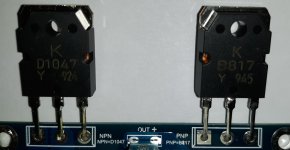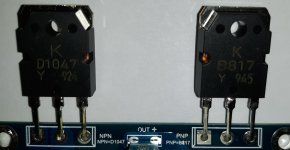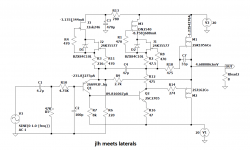There are some higher power designs in AN484A using two small signal stages as described however these use complementary feedback pairs for power output, so the component line up has more than 4 transistors. They had apparently drawn a line for that number at 5W.
Perhaps it is AN-484A then. This does sound quite close:
I wonder where a copy might be found.
Or perhaps I can look at the PCB? Do you have a file or picture showing the PCB and schematic by any chance? For fun I would like to recreate the amplifier and compare the it with my more recent (and vastly more complicated) projects. It was a long time ago but I recall that these simple amplifiers sounded quite good.
see attachment. Let me know if you want the complementary feedback one.
Attachments
see attachment. Let me know if you want the complementary feedback one.
Thank you, that is definitely the right one! Yes, if possible it would be nice to take a look at the complementary feedback one too.
a) Use large radiators and adjust RP1 class A (AB) first watt.
b) Set up RP1 class B (C). Upgrade the VT2 stage (resistor in the emitter). Common emitter output stage(single complementary pair 5200/1943). Add a power transistor in class A SE (as in 1969) to the output. Get the GEM mod? SE A+PP C?
Useful for unstable load impedance. 5 BJT🙂
b) Set up RP1 class B (C). Upgrade the VT2 stage (resistor in the emitter). Common emitter output stage(single complementary pair 5200/1943). Add a power transistor in class A SE (as in 1969) to the output. Get the GEM mod? SE A+PP C?
Useful for unstable load impedance. 5 BJT🙂
Last edited:
I didn't see that thread, but you might be interested in where I sourced the circuit which came from a very useful archive having old issues of Wireless World among others.
Here is the link to the issue for February 1970 - on paper this appeared on page 74. In the pdf you have to scroll down to page 80. https://worldradiohistory.com/UK/Wireless-World/70s/Wireless-World-1970-02.pdf
Here is the link to the issue for February 1970 - on paper this appeared on page 74. In the pdf you have to scroll down to page 80. https://worldradiohistory.com/UK/Wireless-World/70s/Wireless-World-1970-02.pdf
I kept a magazine article by JLH from 1975 entitled "Amplifier Technology" which I found informative and would like to share see https://worldradiohistory.com/Archive-Electronics-Today/Australia/70s/ETI-1975-06.pdf Scroll to page 16 on the pdf.
KEC's semis perform about half way between SANKEN's LAPTS and standard epitaxial power semis which still makes them quite good enough for class A but not the fastest needed for premium class AB where top quality Sanken power transistors are still the best way to go in conventional output stages. Pricewise, the Korean semis are hard to beat in either application. Not surprising; you can't buy them at low prices over the counter at your local industrial supplier so buy them where LJM kits are sold, if you follow the logic, but avoid the several other Chinese brands on offer that are usually marked D1047 and maybe with their brand mark etc. rather than K.....
Well I have a number of D1047 in LJM kits (L20.5 & MX50x2) and I wanted to try Sanken too. So I could get some Sanken from Digikey, do a couple swaps and have both Sanken and KEC D1047 to try.
Is 2SC6145 (and for my other amps 2SA2223) the best Sanken to go for (currently available from an authorized distributor)? I also see 2SC2837 but that is 10A versus 15A which I think is a big difference.
I was thinking of ordering a couple and trying them not only in my mini1969 but also with the 2SA2223 in the LJM kits and for fun perhaps in a recreated amp from Motorola's AN-484.
I was trying to figure out which JLH to order but I am having trouble narrowing down the choices. (So perhaps I upgrade the transistors and caps in the mini1969 as a first step.)
I have real Toshiba 2SC5200 from Mouser and I have a large number of audio grade caps out of dead receivers such as Elna RE3 caps. There are even a couple UES and SILMIC left over from upgrading my main receiver.
Then later I could try to sort through my short list of next JLH contenders:
1. Zero Zone (Large Board) 1969 PNP with outputs marked Sanken 2SA1216
2. Zero Zone (Small Board) 1969 PNP with outputs marked Sanken 2SA1216
3. JLH2003 - Four output devices, no output cap, two current sources.
4. 1969 with 5200 outputs with built in regulator (two versions)
5. 1969 with 5200 outputs with built in regulator (second version)
It is nice to have so many choices but I need to narrow it down.
Any advice/experience one which to strike off the list?
Attachments
-
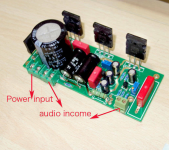 JLH 1969 With Regulator 5200 Another Version.png702.8 KB · Views: 316
JLH 1969 With Regulator 5200 Another Version.png702.8 KB · Views: 316 -
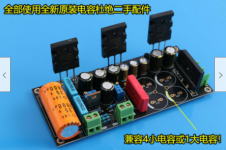 JLH 1969 With Regulator 5200.png178.2 KB · Views: 274
JLH 1969 With Regulator 5200.png178.2 KB · Views: 274 -
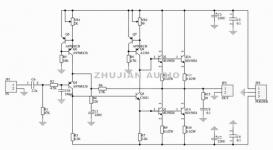 JLH 2003 Kit Schematic.png172.1 KB · Views: 307
JLH 2003 Kit Schematic.png172.1 KB · Views: 307 -
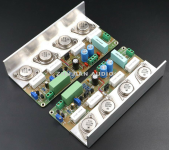 JLH 2003 Kit.png790.6 KB · Views: 787
JLH 2003 Kit.png790.6 KB · Views: 787 -
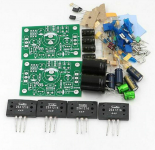 Small Board.png881.6 KB · Views: 677
Small Board.png881.6 KB · Views: 677 -
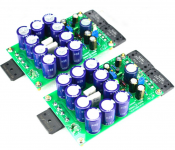 Large Board.png569.9 KB · Views: 698
Large Board.png569.9 KB · Views: 698 -
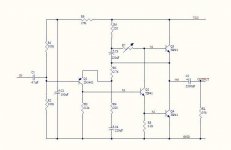 Schematic.jpg25.9 KB · Views: 721
Schematic.jpg25.9 KB · Views: 721 -
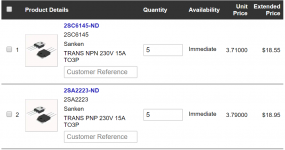 Transistors.png57.2 KB · Views: 729
Transistors.png57.2 KB · Views: 729
KEC's product is marked like this: 5pairs 10pairs KTB817 KTD1047 New Genuine KEC TO-3P Transistor B817 D1047 | eBay
The Chinese sellers don't respect trademarks or copyright laws - they just supply anything that greedy people with cash will go for at the time. They also read forums like diyAudio for sales opportunities arising from ideas like yours and mine and then go to work with the printer, laser etching machine etc and bingo! Sanken semis for US 50c!
You can try the most expensive transistors if you like, but don't confuse technical improvements with subjective impressions - they are often opposing effects for audiophiles. I also think you'll find that spending money on top grade audio transistors for class A amplifiers is heading in the wrong direction. Otherwise, the feature of Sanken's LAPTs is their very high switching speed, a quality required for low crossover distortion in class AB amplifiers. There isn't much value in using them for class A where all you really need is good gain linearity, so On semi's MJ or MJL21193 and 21194 pair are about the best available, referring to lowest distortion - not sound quality. It's quite common for people to look for more distortion in order to hear the rich harmonics possible with the JLH 10W class A design and probably why you see such old circuits and components still as popular as ever. BTW, Sanken's big, MT200 style transistors have been obsolete for some time now so the real ones are now rare and very expensive. What you see in audio kits is obviously not genuine.
From your collection of Chinese kit images though, it seems you'll be starting with those unpredictable, fake components - mostly the semis because you can only assume yours are something like the parts as marked. Using genuine semis from authorized distributors is a lot more expensive than Ebay et al, but I guess we all have to learn our lessons the hard way, when we find our test results (if we do any testing) don't match.
Counterfeit Transistors
The Chinese sellers don't respect trademarks or copyright laws - they just supply anything that greedy people with cash will go for at the time. They also read forums like diyAudio for sales opportunities arising from ideas like yours and mine and then go to work with the printer, laser etching machine etc and bingo! Sanken semis for US 50c!
You can try the most expensive transistors if you like, but don't confuse technical improvements with subjective impressions - they are often opposing effects for audiophiles. I also think you'll find that spending money on top grade audio transistors for class A amplifiers is heading in the wrong direction. Otherwise, the feature of Sanken's LAPTs is their very high switching speed, a quality required for low crossover distortion in class AB amplifiers. There isn't much value in using them for class A where all you really need is good gain linearity, so On semi's MJ or MJL21193 and 21194 pair are about the best available, referring to lowest distortion - not sound quality. It's quite common for people to look for more distortion in order to hear the rich harmonics possible with the JLH 10W class A design and probably why you see such old circuits and components still as popular as ever. BTW, Sanken's big, MT200 style transistors have been obsolete for some time now so the real ones are now rare and very expensive. What you see in audio kits is obviously not genuine.
From your collection of Chinese kit images though, it seems you'll be starting with those unpredictable, fake components - mostly the semis because you can only assume yours are something like the parts as marked. Using genuine semis from authorized distributors is a lot more expensive than Ebay et al, but I guess we all have to learn our lessons the hard way, when we find our test results (if we do any testing) don't match.
Counterfeit Transistors
KEC's product is marked like this: 5pairs 10pairs KTB817 KTD1047 New Genuine KEC TO-3P Transistor B817 D1047 | eBay
Those look different from the markings of the D1047 in the LJM kits. I thought the LJM kits were pretty good at containing genuine good quality parts.
I have enclosed a picture of those laser marks. There is no flat smooth shiny window on the face of these transistors.
So do you think the D1047 are fake in the LJM MX50SE (Pictured)? Identical ones are in the L20.5 and MX50x2.
I did already order genuine 2SC5200 from Mouser (Toshiba) and I am planning a Digikey order later this year with genuine Sanken 2SC6145. (I do want to get a little confirmation that the 2SC6145 is the best one to get from Digikey.) Those are mainly aimed at the LJM amps and perhaps the MA9S2.
For the JLH I have genuine 2N3055 and MJ2955 TO-3 in a bag from 34 years ago when I made a class AB based upon a Motorola datasheet (AN-484).
And I can add a couple more types that are suited for the JLH.
On semi's MJ or MJL21193 and 21194 pair are about the best available, referring to lowest distortion - not sound quality.
I am familiar with the idea that some amplifiers are popular due to the desire to add certain distortion. (Analogous I guess to a tube microphone pre-amplifier or a tube guitar amplifier.) This is why I am comparing both low distortion AB amplifiers like the L20.5 to the little JLH and even the little simple AB amplifiers from the AN-484A application note.
So with that in mind what are your recommended JLH outputs for the most pleasing sound quality? I would like to give those a try along with the TIP41C the mini1969 came with and perhaps the others that I have (for fun) to see what I like best. Of course the TIP41C could be fake. But the 2SC5200 from Mouser is not, and the 2N3055 from 34 years ago from Future Electronics should be genuine. Plus one or two types from Digikey should make for a good selection.
Attachments
2SC5200 power transistors will tend to sound very smooth, perhaps too much so, as already explained but that can be a matter of personal taste. I think people tend to prefer the low order harmonic distortion of the original design and they like to hear details - lots of incidental noises, sounds of players breathing, the woody undertones of the instruments etc. These types of sound effects can all be enhanced to a degree by harmonic distortion. The down side to this approach to audio is that there are different music formats and some don't sound so good with such enhancements. YMMV.
Regarding LJM's transistors, I dare say they could sound similar to KEC's if they use similar chip design but there is no guarantee that what you get is the same spec., same manufacturer, same die process with each purchase. There is no manufacturer ID, Hfe group, date or batch - nothing but a generic type specification and datasheet originated by some publisher titled "Savant IC".
FWIW, when I ordered a second qty of the same D1047/B817 parts from the same aliexpress seller, I did get something marked differently and somewhat different sounding to the first lot. That's why I changed to the KEC identified and grade marked types supplied as genuine, original parts.
I think that LJM is constrained by price competition to use local Chinese product. No doubt he could select and match the critical parts if he has thousands of very cheap parts to choose from and easily sell or return those that don't meet spec.
Regarding LJM's transistors, I dare say they could sound similar to KEC's if they use similar chip design but there is no guarantee that what you get is the same spec., same manufacturer, same die process with each purchase. There is no manufacturer ID, Hfe group, date or batch - nothing but a generic type specification and datasheet originated by some publisher titled "Savant IC".
FWIW, when I ordered a second qty of the same D1047/B817 parts from the same aliexpress seller, I did get something marked differently and somewhat different sounding to the first lot. That's why I changed to the KEC identified and grade marked types supplied as genuine, original parts.
I think that LJM is constrained by price competition to use local Chinese product. No doubt he could select and match the critical parts if he has thousands of very cheap parts to choose from and easily sell or return those that don't meet spec.
Last edited:
KEC's product is marked like this: 5pairs 10pairs KTB817 KTD1047 New Genuine KEC TO-3P Transistor B817 D1047 | eBay
I looked at the seller again from your link and found that they have two listings for Genuine KEC devices. But they are branded differently. One is the listing you linked and the other listing from the same seller is branded like the LJM devices. So I don't know if I can order from that seller and I don't see KEC at any authorized distributors I know of.
Your Link ("Genuine KEC KTD1047"):
Same Seller ("Genuine KEC KTD718" - different part but LJM style branding):
Attachments
Let's be clear, I'm illustrating what I found to be the case more than a year ago. It will become obvious from price comparisons, surface finish and mould ejector pin logos etc. what the parts are and their likely origin. The issue is much the same for any products adapted to fool the unwary buyer and ensure their cash goes to China.
I don't want to turn this thread into a buying guide for Chinese kits and parts so I think we should accept that budgets dictate what we will buy and that may mean using the cheapest possible parts. Some will be good equivalents, others good and bad copies, fakes and otherwise non-genuine parts. There can also be new or used old style products that we may never see again in such a chaotic, unregulated market.
Anyway, I think we should return to the thread topic and make our purchase decisions based on the products sold by authorised agencies rather than platform sellers. You can still buy PCBs and many simple components cheaply but buy the semis from reliable sources, at least until you learn the differences, where they matter, for yourself.
I don't want to turn this thread into a buying guide for Chinese kits and parts so I think we should accept that budgets dictate what we will buy and that may mean using the cheapest possible parts. Some will be good equivalents, others good and bad copies, fakes and otherwise non-genuine parts. There can also be new or used old style products that we may never see again in such a chaotic, unregulated market.
Anyway, I think we should return to the thread topic and make our purchase decisions based on the products sold by authorised agencies rather than platform sellers. You can still buy PCBs and many simple components cheaply but buy the semis from reliable sources, at least until you learn the differences, where they matter, for yourself.
Last edited:
Hi Guys i'm going to build some of these for my desk and possibly my sisters dining room:
DECWARE Tiny Radials
Just itching to try out some omni directional speakers and its a relatively easy build apart from the fact all the dimensions are in inches on the plans!!!
But they need v low power to ensure the speakers aren't blown instantly. ACA are all sold out till Jan so I've ordered one of these. Let me know what you think it looks well built (to me) and the shielded toroid and caps in the power supply look good too.
LP Spirit Pure Class A 1969 Amplifier Computer Desktop Mini Merge Split Type HIFI Audio Power Amp|audio power|power ampa class amplifier - AliExpress
I like the fact the power supply is seperate.
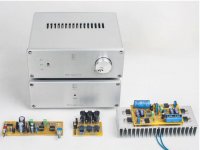
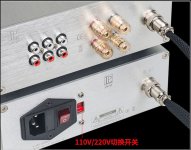
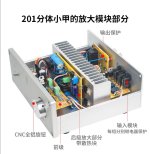
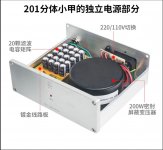
Its Based on 1969 John Linsley Hood Design
DECWARE Tiny Radials
Just itching to try out some omni directional speakers and its a relatively easy build apart from the fact all the dimensions are in inches on the plans!!!
But they need v low power to ensure the speakers aren't blown instantly. ACA are all sold out till Jan so I've ordered one of these. Let me know what you think it looks well built (to me) and the shielded toroid and caps in the power supply look good too.
LP Spirit Pure Class A 1969 Amplifier Computer Desktop Mini Merge Split Type HIFI Audio Power Amp|audio power|power ampa class amplifier - AliExpress
I like the fact the power supply is seperate.




Its Based on 1969 John Linsley Hood Design
Last edited:
- Home
- Amplifiers
- Solid State
- JLH 10 Watt class A amplifier

